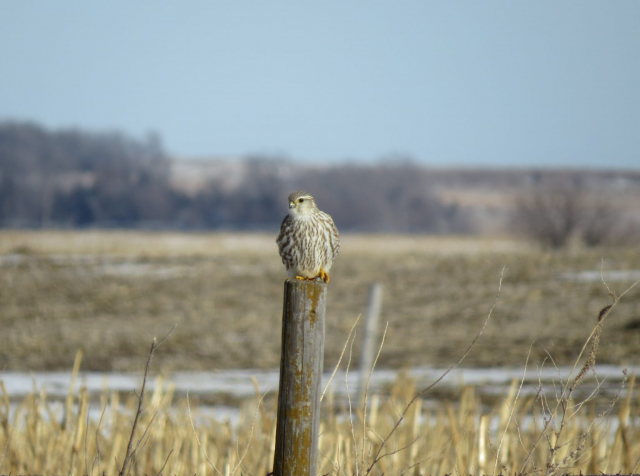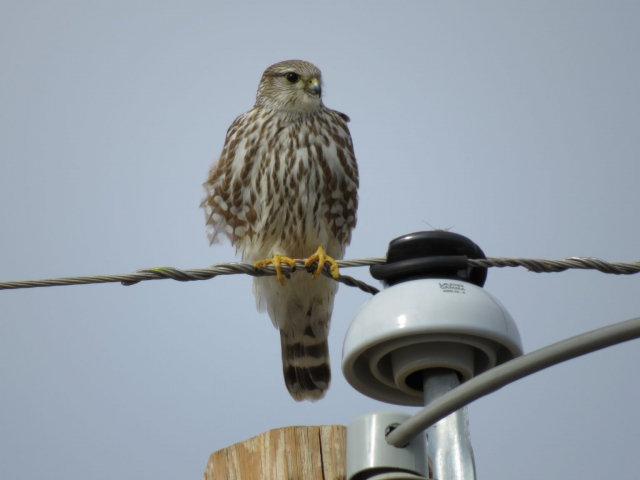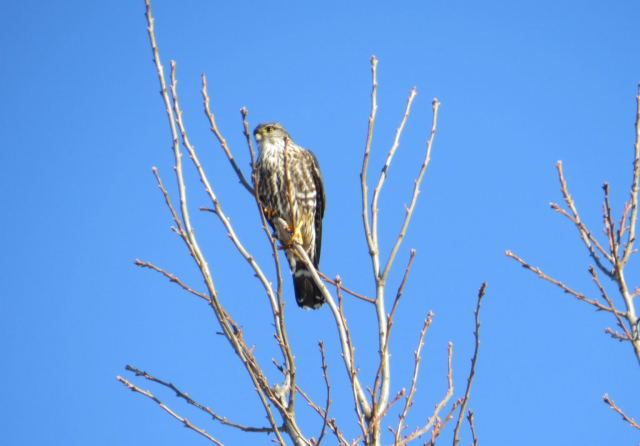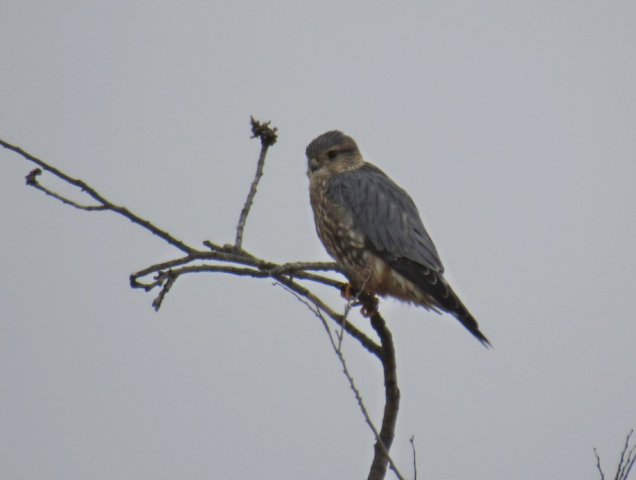Falco columbarius columbarius, F. c. richardsonii
Status: Uncommon regular spring and fall migrant statewide. Rare casual breeder northwest (richardsonii). Uncommon regular winter visitor statewide (richardsonii), south (columbarius).
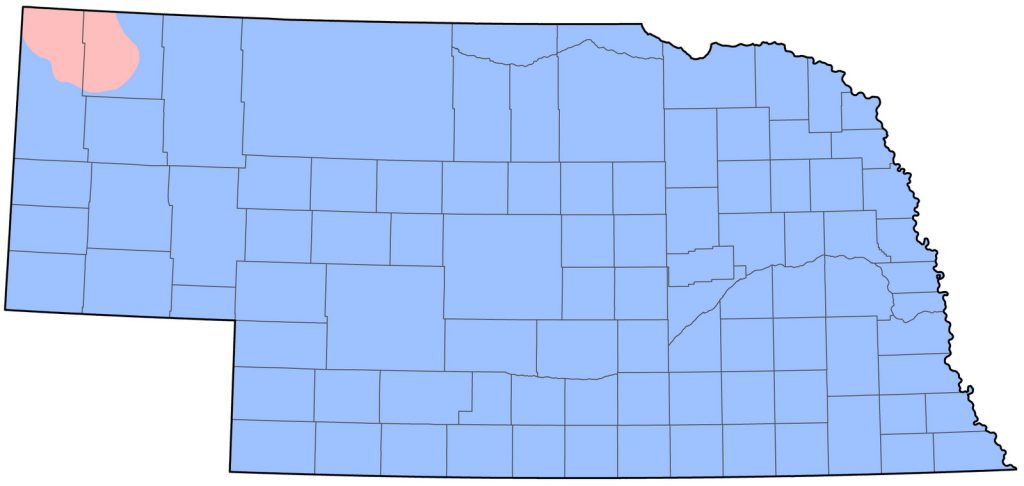
Documentation: Specimens: UNSM ZM12536, 20 Oct 1906 Omaha, Douglas Co (richardsonii), UNSM ZM7702, 1 Oct 1940 Stapleton, Logan Co (columbarius).
Taxonomy: Nine subspecies are recognized, six in Eurasia and three in North America (AviList 2025): columbarius breeding in boreal Alaska and Canada, south to the northern USA but north of the range of richardsonii, suckleyi breeding Pacific Northwest, and richardsonii breeding central and south-central Canada to the north-central USA.
Columbarius and richardsonii occur regularly in Nebraska (Rapp et al 1958), and there is but a single record of suckleyi.
Richardsonii is a northern Great Plains prairie breeder, including northwest Nebraska (Wheeler 2003); it also nests in the Black Hills of South Dakota and nearby eastern Wyoming (Faulkner 2010, Wheeler 2003). Richardsonii accounts for most wintering Merlins in Nebraska (Jorgensen 2012, Wheeler 2003).
Columbarius is a boreal breeder (see Wheeler 2003) and thus a long-distance migrant passing through Nebraska mostly in central and eastern parts of the state; it is rare in migration in Colorado (Andrews and Righter 1992) and “very rare” in Wyoming (Faulkner 2010). It winters in Nebraska, albeit “sparsely”, mostly in the Platte, North Platte, and Missouri River Valleys; most wintering birds are females (Wheeler 2003).
Some authors distinguish paler birds in the western part of the range of columbarius as the subspecies bendirei, noted by Rapp et al (1958) as occurring in Nebraska, but these birds are currently thought to be insufficiently different from columbarius to warrant sub-specific status (Pyle 2008).
Subspecies suckleyi has occurred several times east and south to western Montana and the east edge of the Rocky Mountains to at least the border with Mexico. The single Nebraska report of suckleyi (“black Merlin”) for Nebraska is from Kimball Co 6 Oct 2022 (Mlodinow, eBird Checklist – 6 Oct 2022 – Oliver Reservoir SRA. East of the Rockies there are about ten documented records, including one each for New York in Jan and Massachusetts in Feb, three for Texas Nov-Feb, three for the Colorado Front Range for Mar-Apr, and one for Kansas in Sep (eBird.org, accessed Nov 2023; Wheeler 2003).
Most darker Merlins reported in Nebraska are likely to be females of the “dark form” of columbarius (Wheeler 2003), although one photographed in Harlan Co 16 Sep 2020 appears to be a candidate for suckleyi (Jorgensen, eBird Checklist – 16 Sep 2020 – Harlan County Lake). Additional Nebraska reports of dark to blackish birds are 10 Oct 2008 Saunders Co, 27 Dec 2021 Dakota Co, 1 Jan 2009 Dawson Co, 4 Jan 2020 Garden Co, 15 Jan 1998 Banner Co, and 20 Apr 2009 Garden Co. Of these, the 2009 Garden Co and 2021 Dakota Co birds were photographed and identified as “Taiga” Merlins, The reports from Banner Co in 1998, Saunders Co in 2008, and Dawson Co in 2009 were all described as “very dark” or “blackish” (Silcock 2009) but were not photographed. The 2020 Garden Co record was identified as a “Taiga” Merlin, but not photographed.
Spring: winter <<<>>> May 20, 24, 25 (subspecies not noted); winter <<<>>> Apr 14, 15, 18 (richardsonii); winter <<<>>> Apr 29, May 2, 3 (columbarius)
Later dates away from the Pine Ridge (subspecies not noted) are 2 Jun 2013 Franklin Co, 5 Jun 2000 NNF Bessey, Thomas Co, and 6 Jun 2003 near Imperial, Chase Co.
Later dates for richardsonii away from the Pine Ridge are 27 Apr 2003 Knox Co, 10 May 2022 Douglas Co, and 28 May 2012 Garden Co.
Later dates for columbarius are 8 May 2021 Sarpy Co, and 20 May 2017 Lancaster Co.
Data from eastern Nebraska indicate a peak of occurrence in Apr, probably enhanced due to migrants of columbarius; there is no indication of such an Apr peak in the west, where columbarius is rare. Away from wintering areas in the south and east, data on spring arrival of columbarius are lacking.
Summer: Merlin (richardsonii) had been suspected of breeding on the Pine Ridge since 1938, notably in Squaw Creek Canyon (Hudson 1939), but no direct evidence was obtained until 1975, when a nest with two eggs was found 13 Jun in a ponderosa pine in a sheer-walled canyon in Fort Robinson SP, Dawes Co (Lock and Craig 1975). Lock (1979) reported seeing adults in Jun 1977 northwest of Crawford, Dawes Co, and in Jun 1978 southeast of Crawford. On 9 Jun 1978 another nest was found, also at Fort Robinson SP; this nest was only 1.5 miles from the first and contained one egg and four young chicks (Lock 1979). Success of either nest was undetermined. Other nests, one with five 3-5 days-old eyases and the other with five 5-7 days-old eyases “too young to band”, were found 17 June 1980 in Coffee Canyon and 13 June 1980 in Cedar Canyon, respectively, in northern Sioux County (NGPC, unpublished data). Territorial birds were observed at the Coffee Canyon site in 1982, 1983 and at both Coffee and Cedar canyons in 1991 (NPGC, unpublished data). Nest cards were submitted for Sioux Co 1983 (Bennett 1984) and 1984 (Bennett 1985) without details. The 1983 record may have referred to a nest with eggs 14 miles northwest of Crawford, Sioux Co 7 Jun 1983 (Dinan; Mollhoff 2022). An adult female was observed on a nest, apparently incubating eggs, northwest of Crawford on 7 Jun 1984 (NGPC, unpublished data).
Additional breeding season reports for Sioux Co are 15 Jun 1986, 16 Jun 2025 southwest of Harrison, 28 Jun 1999, 1 Jul 2021, 12 Jul 2001, 16 Jul 1992, 17 Jul 1994, 20 Jul 2012, 5 Aug 1995, and 11 Aug 2018, and for Dawes Co 2 Jun 2008 and 3 Jun 2007.
In 1991 NGPC surveys of sites where nesting or territorial birds had been previously observed documented a total of 10 active nests, all in the Pine Ridge of Sioux and Dawes Cos. Five young were observed at one of these nests 14 Jul; another contained four young 13 Jul.
Nesting raptor surveys conducted on Nebraska National Forest and Oglala National Grassland properties by Pine Ridge Ranger District staff in 1994 produced additional evidence for breeding (Muenchau 1994). On 19 Jul 1994, an adult pair and at least two fledglings were observed approximately 12 km south southeast of Chadron, Dawes Co, and on 20 Jul 1994, a male and a fledgling were observed about 8 km southwest of the unincorporated village of Joder in Sioux Co (Muenchau 1994). Only one adult Merlin and no evidence of nesting were observed during similar surveys in 1996 (Muenchau 1996). There is no evidence of breeding in Nebraska since 1994.
As with Peregrine Falcon, several northern Great Plains cities have established urban-breeding Merlins since the 1980s (Warkentin et al 2005), but so far none have been established in Nebraska.
Fall: Aug 25, 26, 26 <<<>>> winter (subspecies not noted); Sep 3, 3, 4 <<<>>> winter (columbarius); Sep 21, 24, 27 <<<>>> winter (richardsonii)
Earlier dates (subspecies not noted) are 18 Jul 2025 Dawson Co, 6 Aug 2024 Seward Co, 7 Aug 2022 Gosper Co, 8 Aug 2018 Knox Co, 11 Aug 2018 Sioux Co, 19 Aug 2005 Lincoln Co, 20 Aug 2022 Jefferson Co, and 20 Aug 2023 Knox Co.
Earlier dates for columbarius are of a molting female found injured in Cass Co 18 Aug 2000 and transferred to the Carolina Raptor Center where it died 3 Sep 2003 and is now a specimen (#20229) in the North Carolina State Museum (vertnet.org, accessed Sep 2017), and 24 Aug 2014 Buffalo Co.
Earlier dates for richardsonii away from the Pine Ridge are of one at Lake Ogallala, Keith Co “early Aug” 1993 (Brown and Brown 2001), 7 Aug 2022 Gosper Co, 10 Aug 2024 Dundy Co, 25 Aug 2024 Buffalo Co, 31 Aug 2020 Kimball Co, 1 Sep 2019 Lancaster Co, 12 Sep 2021 Johnson Co, and 14 Sep 2020 Lancaster Co.
Most Merlin reports in the east are in Sep-Oct, probably as numbers of arriving richardsonii coincide with peak migration of columbarius. Dec dates may be of birds attempting to overwinter (see Winter).
- High counts: 4 in the eastern Rainwater Basin 26 Sep 1999, 4 in the northern Panhandle 22 Oct 2000, and 4 in Knox Co 12 Nov 2000.
A survey in eastern Nebraska (Loren and Babs Padelford, personal communication) yielded a maximum for any one year of 10 sightings.
Winter: As a species, wintering Merlins occur statewide, although numbers are lower in the east. Rosche (1982) listed it as an “uncommon winter visitant” in northwest Nebraska and single birds are commonly reported on CBCs statewide. The winter range underwent a northward expansion on the Great Plains 1960-1990 (Warkentin et al 2005); Nebraska reports suggest this increase may in part result from increasing numbers of wintering columbarius.
Most wintering birds are richardsonii, which are more common westward, and common in eastern Colorado (Wheeler 2003).
Regarding wintering of columbarius, Wheeler (2003) stated “Very sparse wintering in the interior states”; Wheeler’s maps showed wintering along the Platte and South Platte River Valleys in Nebraska, but eBird maps for Dec-Feb show several records along the Missouri River Valley as well in the Platte River valleys.
- High counts: 4 in the Panhandle 24 Jan 1999 and 4 on the Norfolk CBC 17 Dec 2005.
Images
Abbreviations
CBC: Christmas Bird Count
NGPC: Nebraska Game and Parks Commission
NNF: Nebraska National Forest
SP: State Park
UNSM: University of Nebraska State Museum
Literature Cited
Andrews, R., and R. Righter. 1992. Colorado birds. Denver Museum of Natural History, Denver, Colorado, USA.
AviList Core Team, 2025. AviList: The Global Avian Checklist, v2025. https://doi.org/10.2173/avilist.v2025.
Bennett, E.V. 1984. 1983 Nebraska nesting survey. NBR 52: 47-50.
Bennett, E.V. 1985. 1984 Nebraska nesting survey. NBR 53: 46-49.
Brown, C.R., and M.B. Brown. 2001. Birds of the Cedar Point Biological Station. Occasional Papers of the Cedar Point Biological Station, No. 1. Nebraska, USA.
Faulkner, D.W. 2010. Birds of Wyoming. Roberts and Company, Greenwood Village, Colorado, USA.
Hudson, G.E. 1939. Some ornithological results of a six-week’s collecting trip along the boundaries of Nebraska. NBR 7: 4-7.
Jorgensen, J.G. 2012. Birds of the Rainwater Basin, Nebraska. Nebraska Game and Parks Commission, Lincoln, Nebraska, USA.
Lock, R.A. 1979. A second nesting record for Merlins in Nebraska. NBR 47: 39.
Lock, R.A., and R. Craig. 1975. Merlin nest in Nebraska. NBR 43: 78-79.
Mollhoff, W.J. 2022. Nest records of Nebraska birds. Nebraska Ornithologists’ Union Occasional Paper Number 9.
Muenchau, B.L. 1994. 1994 raptor nest survey summary. Pine Ridge Ranger District, Nebraska National Forest/Oglala National Grassland, Chadron, Nebraska, USA.
Muenchau, B.L. 1996. 1996 raptor nest survey summary. Pine Ridge Ranger District, Nebraska National Forest/Oglala National Grassland, Chadron, Nebraska, USA.
Pyle, P. 2008. Identification Guide to North American Birds. Part II, Anatidae to Alcidae. Slate Creek Press, Bolinas, California, USA.
Rapp, W.F. Jr., J.L.C. Rapp, H.E. Baumgarten, and R.A. Moser. 1958. Revised checklist of Nebraska birds. Occasional Papers 5, Nebraska Ornithologists’ Union, Crete, Nebraska, USA.
Rosche, R.C. 1982. Birds of northwestern Nebraska and southwestern South Dakota, an annotated checklist. Cottonwood Press, Crawford, Nebraska, USA.
Silcock, W.R. 2009. Winter Field Report, December 2008 to February 2009. NBR 77: 18-34.
Warkentin, I.G., N.S. Sodhi, R.H.M. Espie, A.F. Poole, L.W. Oliphant, and P.C. James. 2005. Merlin (Falco columbarius), version 2.0. In The Birds of North America (A. F. Poole and F. B. Gill, Editors). Cornell Lab of Ornithology, Ithaca, New York, USA. https://doi.org/10.2173/bna.44.
Wheeler, B.K. 2003. Raptors of Western North America. Princeton University Press, New Jersey, USA.
Recommended Citation
Silcock, W.R., and J.G. Jorgensen. 2025. Merlin (Falco columbarius). In Birds of Nebraska — Online. www.BirdsofNebraska.org
Birds of Nebraska – Online
Updated 25 Aug 2025
